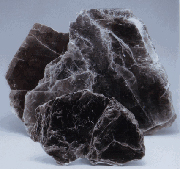| What's MICA |

Raw ore of Indian Muscovite |
The photo shows natural Indian muscovite. The biggest one is 2cm thickness
and 50cm
width. In our office, a huge muscovite 0,5cm thickness and 100cm width is decorated
on the wall. There would be no other minerals than mica which grows so
vastly in planar
direction.The mica ore used for industrial purposes mostly are mined in
India following
China, Canada, Finland and Brazil. The crystal size and purity depend greatly
on its
mining site and the application differs respectively. |
The important characteristics of mica is that the crystalline structure
forms layers that can be easily split or delaminated into
thin sheets due to its elasticity. These sheets, usually semi-transparent or tinted through green or brown, can be easily cut off
with scissors or a cutter. It is electrically and thermally stable.
Mica is used in various industries today. However, it has been only three
decades since it was widely accepted in diverse
equipment. As an industrial material, plate or ground mica is popular.
Platy mica has a long history in which was used as a
vibration plate in the microphone in the late 19th century and this development resulted in a wide spread of telephones.
In the beginning of 20th century, it was replaced with glasses of the bridge-spacer
in electronic valves and enabled
mass-production of the electronic valves. Sheet mica is also used in many
industries, such as heat-resistant insulating
material, condenser and stove heater windows, etc. For these applications, natural sheet mica had long been used, however
sheet-like mica that is made from ground mica bonded with resin is commonly
used in heat-resistant insulating materials in
recent years.
In other cases, mica has been used to decorate plastered walls and fusuma gritter since ancient times, and even now, our
mica is used to repair these cultural properties. Nowadays, mica powder
is widely known as an inorganic powder which
provides excellent physical properties and functions to materials. For
improving the texture of cosmetics, it is added in
foundation . As a functional filler, it is used in plastics and paints
in automotive, electronic and architectural industrieses.
It's also used as a mold release agent for tires and sanitary pottery.
In automotive industry, a pigment named pearl mica is often used for paint which is coated with oxidized film (ex. oxidized
titanium, etc.) different in reflective index. Another example shows that
color mica which is composed of 1-mm colored mica
grains is used as color flakes in synthetic marble stones.
The table below shows the major industries using mica powders. |
| Market |
Performance |
| Cosmetics |
Improve texture, provide glossy feeling,, caking prevention |
| Plastics |
Improve rigidity and heat-resistance, reduce warpage and shrinkage, provide
vibration
suppression and barrier |
| Paint |
Anti-corrosion, waterproof, reduce coating shrinkage, provide vibration
suppression, improve
heat-resistance |
| Rubber |
Improving hardness and heat-resistance, provide vibration suppression,
improving heat-resistance
and performance of mold release |
| Ceramics |
Improving performance of mold release and fire-proof of building material boards, provide machinability |
| Others |
Improving performance of brake friction materials, base material of pearl mica |
|
|
|